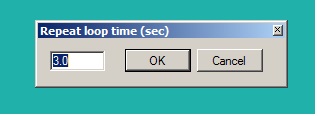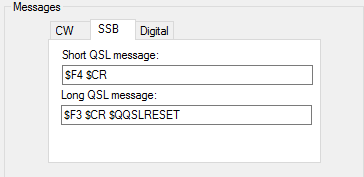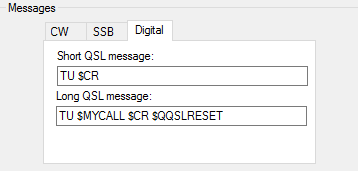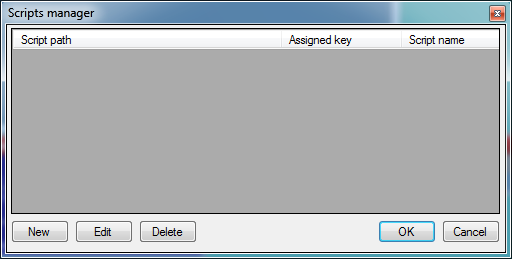Difference between revisions of "Menu Tools"
(→Data entry) |
(→Data entry) |
||
| Line 97: | Line 97: | ||
** For ESM to work correctly with prefill database when using bandmap spots, ensure that Tools>Data Entry>Don't prefill exchange in ESM mode when Spot is grabbed is ticked. | ** For ESM to work correctly with prefill database when using bandmap spots, ensure that Tools>Data Entry>Don't prefill exchange in ESM mode when Spot is grabbed is ticked. | ||
| − | *** To enable ESM to log the QSO instantly on sending instert - change the Search and Pounce message for INSERT to $F2 $CR | + | *** To enable ESM to log the QSO instantly on sending instert - change the Search and Pounce message for INSERT to $F2 $CR. |
| − | |||
* '''ESM mode change focus on LOGGEDCALL macro''' | * '''ESM mode change focus on LOGGEDCALL macro''' | ||
Revision as of 07:07, 14 July 2019
Contents
Repeat loop
Text command: RPT / NORPT
Turns on or off the CQ repeat loop function. After pressing F1 (CQ memory) and when message is transmitted, loop will wait for n seconds (default is 3 seconds) and if there isn't any key pressed in qso callsign field (or esc key), after n sec period is exceeded, content of F1 memory will be transmitted again automatically. The setting time window appears like:
Repeat loop status function is visible in Rate window, if it is activated. Repeat loop timing function is visible in "Operating info" window.
Also, if during transmitting of message any key is pressed in callsign QSO field (or ESCAPE key is pressed), transmission stops immediately and repeat loop is deactivated. It is automatically restored when F1 key is pressed.
Intelligent Quick QSL
Shortcut: ALT+Q
Intelligent Quick QSL (IQQSL) is a tool for generating QSL messages depending on QSO criteria, based on 2 main choices:- 1. Basic QSO Number based
2. Adaptive QSO rate Based
IQQSL automatically replaces the PLUS message in your message macros without having to change the PLUS macro.
Choice 1. Basic QSO numbers:- This is the simplest option and will replace the PLUS message with the information set in the SHORT MESSAGE, then every X number of qso's, which is user set with the "send long qsl message after qso count" option, the LONG MESSAGE will be sent. To enable, select this option and set the QSO count required.
Choice 2. QSO rate based adaptive IQQSL:-
Using the QSO rate based option we can have more control over when the LONG QSL message is sent. Criteria is set for 5 different calculated QSO rates, the number of QSO's used for the calculation can also be altered, the default is 3. Using the default settings, as the instantaneous rate calculated by the last 3 QSO's increases, the long QSO message is sent if "Send long QSO every" X Seconds or "Send long QSO count of" X number is exceeded. To enable, select this option and adjust the settings to suit your LONG QSL message requirements.
QSL Message macros can be set for CW SSB or DATA modes
Adding $QQSLRESET to the CQ message will reset the Intelligent Quick QSL counters, this should be used. Intelligent Quick QSL has separate counters when using SO2R mode for R1 and R2.
Redefine keyboard keys
- Text command:
DEFINEKEYS
- Text command:
DXL commands can be assigned to any of the keyboard keys (or combination of keys) using the functions in this window.
Once the redefine keyboard keys window is open, select the new key from the keyboard (or combination of keys) that you want to assign to a DXL command then press the original DXL command key (or combination of keys) you want to
re-assign.
Once OK has been clicked and the redefine keyboard keys window has closed the new key (or combination of keys) will execute the DXL command along with to the old key (or combination of keys). NOTE: This function does not remove the DXL command from the original key (or combination of keys), so keys that are already mapped in the DXL coding cannot be used as a redefined key (or combination of keys).
Data entry
File:Tools data entry menu1.png
- Exchange guessing (not valid for serial #).
- If you have a specific exchange database available for a specific contest, the pre-fill to the report field action can be:
- Pressing the space bar - the report field is completed when you press the spacebar. (Best for ESM)
- Automatically - the report field is completed while you are typing the call-sign.
- After timeout - the report field is completed automatically after few seconds you have typed the call-sign.
- Enable ESM mode
- Text command:
ESMandNOESM - Text command:
ESMONandESMOFF
- Text command:
- The function "Enter Sends Message", better known as "ESM", enables the relevant CW/RTTY message to be sent by only using the "Enter" key.
Run mode
When in Run mode ESM sends messages from the Run section of CW messages. Message logic is as follows: * With cursor in an empty log callsign entry field - [Enter] will send F1 message. * With cursor in a filled log callsign entry field - [Enter] will send INS message. After this, to prepare entering the exchange, you need to move the cursor to the exchange field by pressing the space bar, or include $SPACEBAR in your INS macro. * If the exchange is not correctly received, you can either press F6 or leave the exchange field empty and press [Enter] which sends the F6 message (typically "NR?"). * When the exchange field is complete and correct - [Enter] will send PLUS message, which normally includes logging the QSO.
S&P mode
When in S&P mode ESM sends messages from the Search & Pounce section of CW messages. Message send logic is as follows: * If exchange field is empty - [Enter] will send F1 message. * If exchange field is filled - [Enter] will send INS message. * To log the QSO, hit [Ctrl][Plus] or [Plus] if the PLUS macro contains only logging. ** For ESM to work correctly with prefill database when using bandmap spots, ensure that Tools>Data Entry>Don't prefill exchange in ESM mode when Spot is grabbed is ticked. *** To enable ESM to log the QSO instantly on sending instert - change the Search and Pounce message for INSERT to $F2 $CR.
- ESM mode change focus on LOGGEDCALL macro
- If checked, $SPACE macro will be activated every time $LOGGEDCALL macro is sent and ESM mode is active.
- Enable Run/SP switching
- Text command:
RUNSPandNORUNSP - Text command:
RUNSPONandRUNSPOFF
- Text command:
- Activate run / Search & pounce switching with CTRL-TAB key command.
- Enable Automatic Run/SP selection
- Text command:
AUTORSPandNOAUTORSP - Text command:
AUTORSPONandAUTORSPOFF
- Text command:
- Automatic Run / Search & Pounce switching mode, if frequency changed away from CQ (run) frequency then DXlog.net will switch to search & pounce mode.
- Enable CW Cut Numbers Translation
- If cut numbers are entered into the exchange field, DXlog.net will automatically change the cut numbers to the numerical equivalent.
- Use INSERT mode in RCVD fields
- Switch to INSERT mode instead of OVERWRITE mode for all log RCVD fields.
- Enable Morse Runner simulation
- Enables linking to Morse Runner for QSO and Contest training purposes.
- Morse Runner will be started automatically when this option is selected. A full SO2R simulation is available,
- and a special version of Morse Runner is shipped with the standard DXLog.net installation.
- If you use SO2R mode, two copies of Morse Runner will be started. When the simulation is disabled or
- the active log is closed the Morse Runner process(es) will be closed.
- NB: The Morse Runner screens are not visible by default when the simulation is started.
- If a CQ WW log is open, the CQ WW configuration will be used. If any other contest is used, the
- default Morse Runner simulation is used. Additionally, the F1 and F2 CW messages defined
- in DXLog.net are now used by Morse Runner instead of the default messages.
- The following special keyboard shortcuts are available in the simulation:
CTRL+ALT(or AltGR)+PAGEUP/PAGEDOWNchanges the monitor volume.CTRL+ALT(or AltGR)+LEFT/RIGHTchanges the receiver bandwidth.SHIFT+UP/DOWNchanges the RIT.CTRL+Shift+Left/Rightchanges pitch level down/up.
- Prefill field values - callsign
- Entering something in this window will prefill the callsign field with the entry automatically.
- This is used in some local country contests (9A especially) where the callsign prefix will always be the prefilled value.
- Enable grab call from decoder window in digi mode
- When checked, DXlog.net will automatically grab the last known (highlighted) callsign from the RTTY decoder window.
- Spacebar Reserve Serial Number
- In contests where a multi transmitter station requires a serial number sequence, and the serial number server is enabled in the networking options,
- this option will enable DXL to reserve a serial number on pressing the space bar. If this option is un-ticked then only the macro command $RESERVENR will reserve a serial number from the server.
- Cancel serial number reservation only if callsign field is empty
- When serial number reservation is used and this option is checked, it will cancel serial number reservation during wipe qso function only if callsign field is empty.
- Log QSO immediately when CR macro found
- When checked will log the QSO if valid when the CR command is found in a message macro.
- Don't prefill exchange in ESM mode when spot is clicked
- If checked, prefill database info will not be entered when in ESM mode and selecting a spot from the bandmap or dxcluster announcements window (This is required for ESM to work correctly in S&P mode).
- F1 key returns to RUN mode always
- If checked, pressing F1 (normally the CQ key) will switch to RUN mode before sending the F1 message.
- Refresh multiplier list on focused radio change
- TBD
- Disable RCVD field autoskip
- TBD
Message editors
- Enable SO2R scenario on the fly editor
- If checked and operating mode is advanced SO2R, the editor for a standard message (SHIFT+F key) will also show
- the active SO2R macro lines for radio1 and radio2, this allows quick edit of messages without opening the full scenario editor.
- On the fly editor focus on scenario line
- If checked, when on the fly editor window is shown, the line with focus will be radio 1 or radio 2 scenario (depends if the user
- pressed SHIFT+F key when radio 1 or radio 2 had focus). If not checked, standard cw message line will be the focus.
- The user can change the focus in the editor screen by pressing the TAB or SHIFT/TAB key.
Scripts Manager
Support for custom written C# scripts, this enables additional functionality.
Custom scripts are written in C# language and they are compiled during DXlog.net runtime.
Scripts can be assigned to shortcuts and will be executed when the shortcut key is pressed.
Scripts can be called by name from CW/Digi message as macro command prefixed with "$!".
For example, if CW/Digi message contains $!SCRIPT1, it will execute script with name SCRIPT1.
Scripts can be enabled and disabled from macros using the $!ENABLE!SCRIPTNAME and $!DISABLE!SCRIPTNAME syntax.
However, be aware that event handlers in scripts will not be disabled using only this mechanic but requires
a subsequent RELOAD or restart of DXLog.net to stop.
Additional
- Load a targets file
- Use this option load a rates target file for the contest you are operating in, file extension *.OBF is used.
- Export a targets file
- Use this option to create a rates target file from the currently loaded contest, file extension *.OBF is used
- Reset Interfaces
- Shortcut:
Ctrl+Alt+R - Text command:
RESET - Closes and re-opens serial port and pipe connections to radios, keyers, SO2R devices etc.
- Same as entering Configure Interfaces and clicking OK.







